Despite wide speculation over whether an en primeur campaign could proceed at all in 2020, this year’s campaign is now more or less complete, and Wine Lister’s scores are in. Bordeaux 2019s exhibit high quality across the board, receiving frequent comparison with recent great vintages – 2016, 2015, 2010, and 2009.
Wine Lister has now published its latest Wine Leagues on the new vintage – examining which Bordeaux 2019s rank best for WL score in each major appellation.
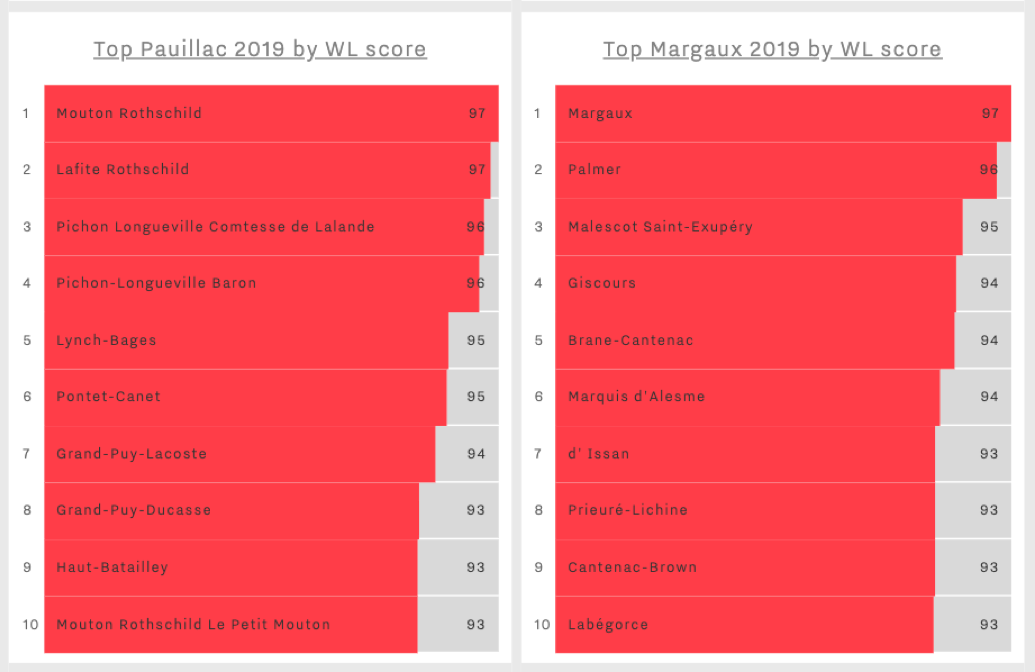
Pauillac First Growths, Lafite and Mouton, lead the appellation’s league of top 2019s by WL score, with a joint score of 97. Pichon Comtesse and Pichon Baron follow suit with 96 – the latter achieving its highest WL score since its 2016 vintage. Wine Lister partner critic Neal Martin describes Pichon-Baron 2019 as having “a very refined bouquet” and a “silky smooth, creamy texture”, stating it “retains all the classicism you could ask for”.
The league of Margaux 2019s by WL score is topped by the appellation’s namesake property, whose latest release joins fellow Pauillac Firsts with a score of 97. Following Palmer’s entry with 96, Malescot Saint-Exupéry 2019 achieves the château’s highest ever WL score (95). Wine Lister partner critic, Antonio Galloni notes that the 2019 is “a striking wine that is sure to find many admirers”, recounting an “interplay of earthy and savoury notes with rich, dense fruit… utterly captivating”.
There are four Value picks featured in the league of Margaux 2019s by WL score, with Labégorce, Malescot Saint-Exupéry, Marquis d’Alesme, and Prieuré-Lichine all achieving scores of 93 and above, at under £35 per bottle (in-bond).
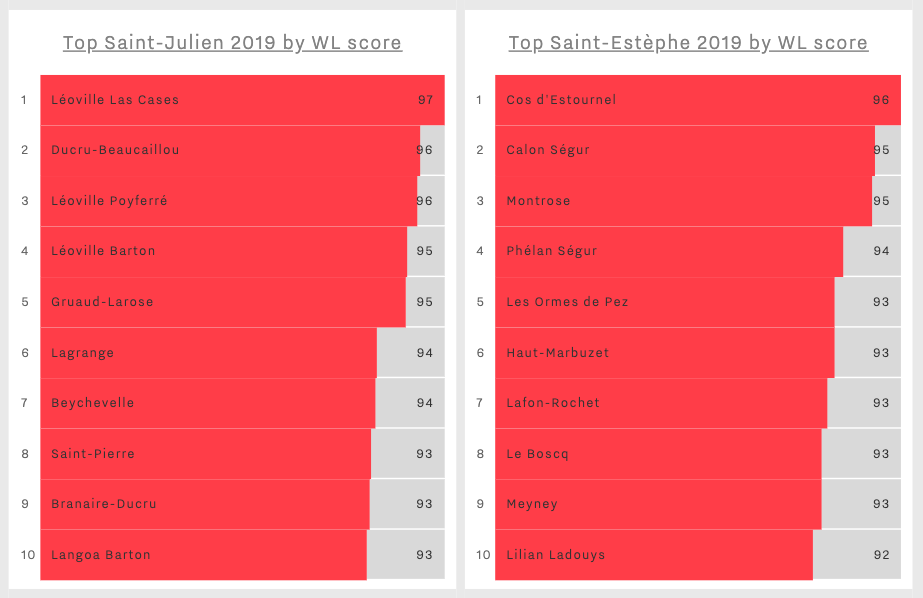
In Saint-Julien, Léoville Las Cases 2019 achieves a WL score of 97, matching that of its 2018 and 2016 vintages. Ducru-Beaucaillou and Léoville Poyferré appear in joint-second place with 96 – achieving their highest WL scores since 2016 and 2015, respectively. Ducru-Beaucaillou 2019 performed notably well at tastings, with Neal Martin, awarding it 96-98 points. He notes its “filigree tannins, pitch perfect acidity and a sensual, satin-like texture”, concluding that the wine is “outstanding in terms of persistence”.
With a score of 96, Cos d’Estournel 2019 tops the league for Saint-Estèphe 2019s by WL score, matching its successful 2018 and 2016 vintages. Writing for JancisRobinson.com, James Lawther describes the vintage as “powerful but carefully constructed and precise”, noting “a lovely mellow quality to such a muscular wine”. While both falling one WL score below their previous vintage, Calon Ségur and Montrose appear second in the appellation’s league, with a shared score of 95.
Branaire-Ducru 2019 and Meyney 2019 exhibit notable value within their appellations – both achieving WL scores of 93 at £29 and £19 per bottle (in-bond), respectively.
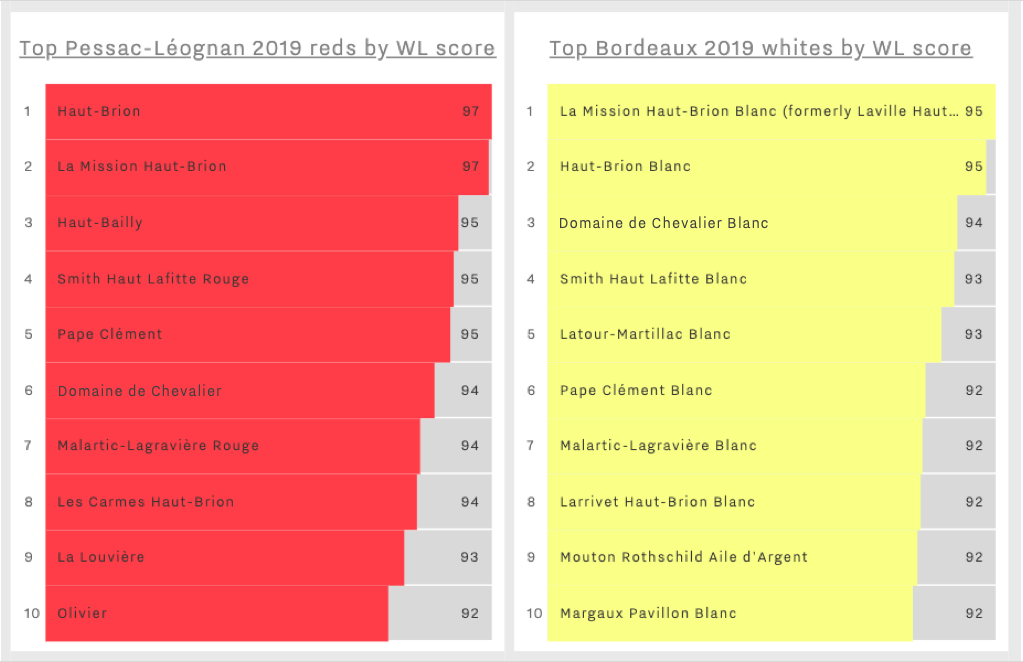
Haut-Brion and La Mission Haut-Brion perform notably well in 2019, achieving joint-first place in the league of top Pessac-Léognan 2019 reds by WL score. As examined in a previous Bordeaux 2019 en primeur blog, the en primeur darling, Les Carmes Haut-Brion, shows clear qualitative success in 2019, and its small production levels and smart en primeur pricing has once again made it a clear campaign buy. Another promising pick from Pessac-Léognan, Olivier 2019 achieves Value pick status at c.£20 per bottle (in-bond), and achieves the château’s highest WL score (92). Antonio Galloni recounts “smoke, licorice, cured meat, graphite and savory herbs infuse the 2019 with striking aromatic intensity to play off its sumptuous fruit”, concluding that the wine is “Very good”.
Haut-Brion and La Mission Haut-Brion attain joint-first place for their whites as well as reds in 2019, achieving scores of 95 in the league of top Bordeaux 2019 whites by WL score. Latour-Martillac Blanc 2019 achieves the highest WL score seen across its vintages (93) – one WL score above Pape Clément Blanc’s 92. At c.£21 per bottle (in bond) Latour-Martillac Blanc 2019 enters the market 10-30% below the current market prices of vintages 2016-2018, showing good value for its quality. Neal Martin notes on the latest vintage: “subtle tropical notes of pineapple and orange rind with hints of strawberry come through on the finish”.
On the right bank, the league of top 10 Saint-Emilion 2019s is crowned by Figeac’s high-scoring 2019. Up one point on its 2018, Figeac’s latest release achieves the highest WL score of all Bordeaux 2019s (98). Figeac 2019 illustrates the château’s impressive upward quality trajectory, which has seen its WL score slowly but surely increase from 91 in 2008. Neal Martin gives the latest vintage 97-99 points, describing it as “exquisitely defined… a deeply impressive, intellectual Figeac”.
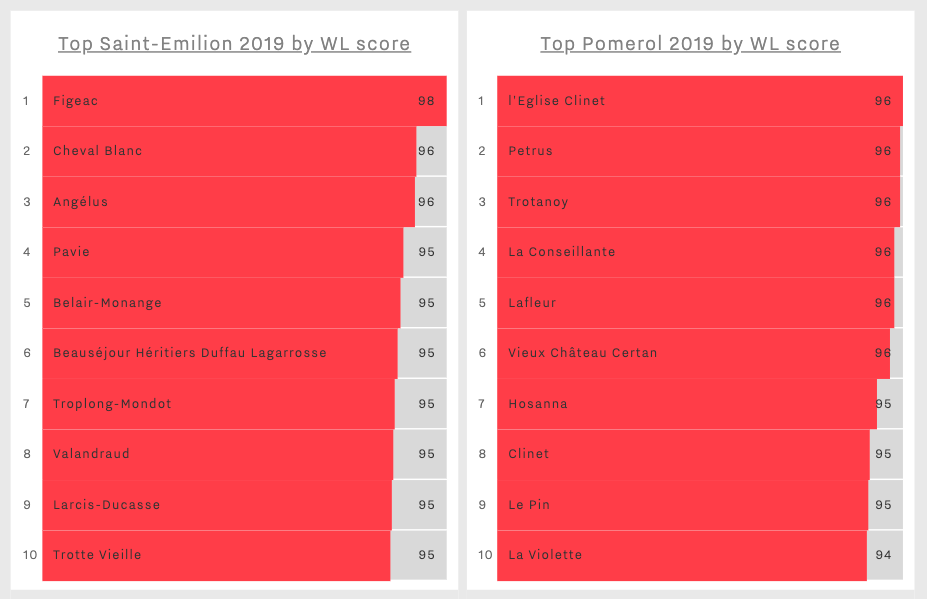
La Conseillante, Lafleur, l’Eglise Clinet, Petrus, Trotanoy, and Vieux Château Certan share the top WL score of Pomerol 2019s (96), separated by mere decimals. A release of note, l’Eglise Clinet 2019 is the last vintage of the late Denis Durantou, who sadly passed away in May. Neal Martin’s impressive score of 97-99 suggests the last vintage was his best, adding, “the perfect way to remember and raise a toast to one of Pomerol’s finest vignerons”.
Click here to view all Wine Leagues. Pro users have access to a more extensive set of Leagues and can log in to access here.
As the first major week of Bordeaux 2019 en primeur releases draws to a close, this morning (Friday 5th June) saw the release of the “first of the Firsts”, and the other reds from the Lafite stable.
Carruades de Lafite 2019 opened the stage with a price of £158 per bottle (in-bond), making it the least expensive Carruades available on the market. The Wine Lister team felt the quality of Carruades saw a significant jump up in 2018, and from what we have heard, the 2019 matches it. With this in mind, and given that volume released onto the market is 50% less than last year, this is a sure buy for anyone seeking access to the Lafite prestige with more approachability.
The grand vin, Lafite 2019, has been released at £426 per bottle in-bond – a discount of c.20% on the 2018’s current market price. The crucial factor this year are the volumes available – also 50% less than last year. On top of this, the single tranche released means buyers will only have one shot to get their hands on the 2019 en primeur (as far as we know). Domaines Baron de Rothschild’s Commercial Director, Jean-Sébastien Philippe, calls Lafite a “modern classic” in 2019, with precision, length, and finesse, but impressive ripeness, making it more approachable than the likes of 2018 or 2016.
Both Lafite and Carruades were cited by the trade as seeing sharp rises in demand (see below) according to Wine Lister’s 2020 Founding Members’ survey. Competition to access both of these wines will therefore likely be high.

Lafite’s Pomerol property, L’Evangile, has released its 2019 grand vin at £146 per bottle in-bond, 15% below the current market price of the 2018. Once again, the Wine Lister team noticed a distinct quality step up in Evangile’s 2018, which we’ve heard has been equalled in 2019. The 2019 reportedly expresses well the move towards a more modern style, and a wine of increasing tension, florality, and freshness, without losing the plush Pomerol profile.
Duhart-Milon 2019 has also been released, at £52 per bottle in-bond. Though the release price puts it more or less in line with market prices of back vintages 2018 and 2016, there is justification to be found in the excellent quality that the Lafite team believe is there in 2019. Philippe explains that Duhart-Milon’s vines sit on a cooler terroir than those of the estate’s Pauillac neighbours, which means in cooler vintages, the wine can be somewhat “austere”. The increasing average temperatures that Bordeaux has seen during recent growing seasons (2018, 2016, and 2015 vintages) therefore only serve to improve the quality of Duhart-Milon, and 2019 certainly had its fair share of heat.
Keep up to date with further Bordeaux 2019 en primeur releases through Wine Lister’s twitter, or through our dedicated en primeur page.
As en primeur 2018 picks up pace, we consider the 10 Bordeaux wines that any fine wine collector should acquire for their collection. These are based on the results of Wine Lister’s latest Founding Member survey, gathering the views of over 50 key players in the global fine wine trade.
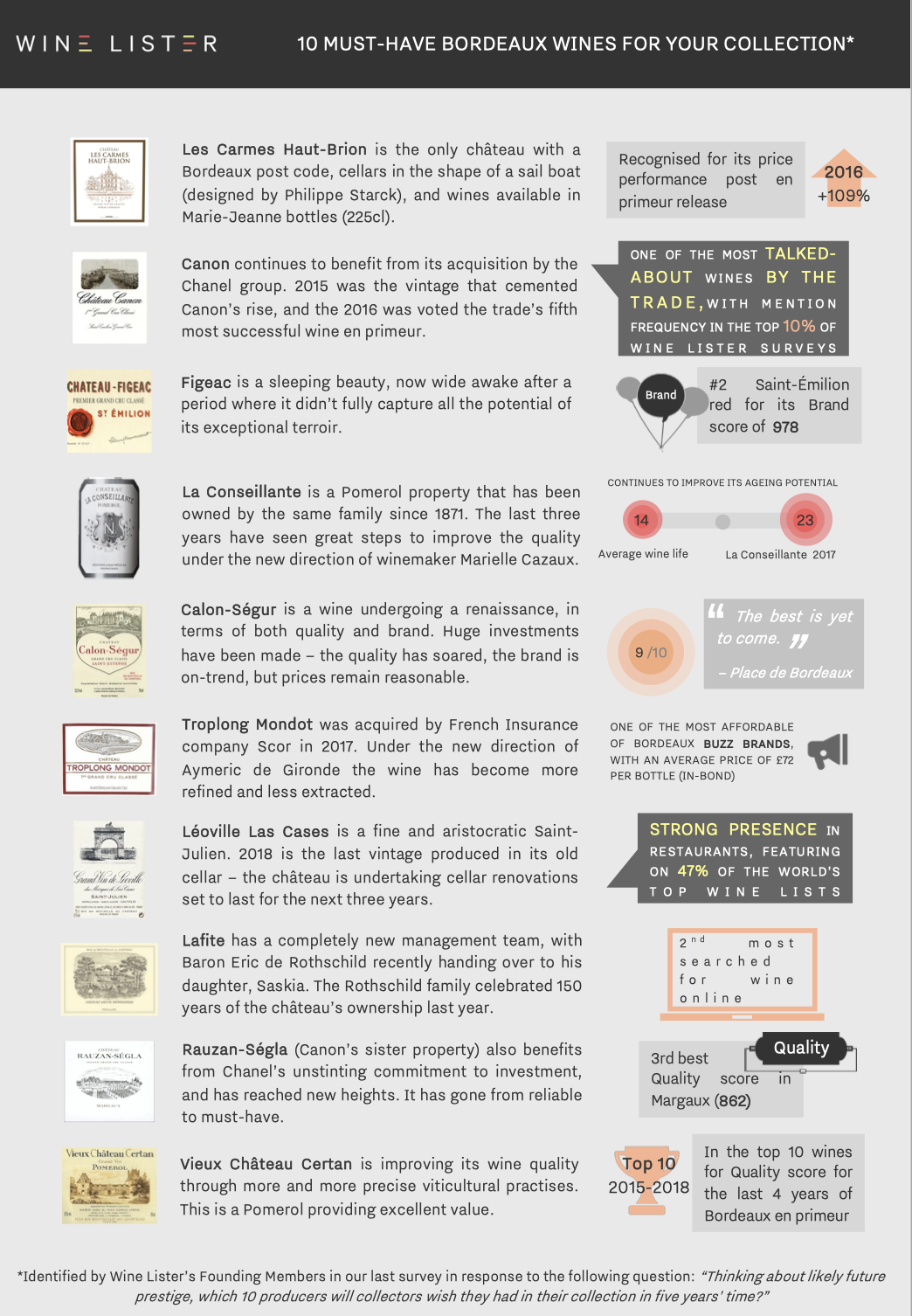
You can download this slide here: 10 must have Bordeaux wines for your collection
While the market for Bordeaux remains sturdy, and interest in Burgundy continues to grow, it is easy to overlook other traditional European fine wine regions despite their impressive quality and value for money, particularly compared with upward-spiralling Burgundian price tags. This week’s top five looks at such a region – the best of Spain’s iconic Rioja.
In first place is Bodegas Lopez de Heredia’s Rioja Gran Reserva with an overall Wine Lister score of 910. Though by no means the most expensive of the five (at £63 in-bond per bottle), it earns the highest Economics score of the group (926). This is down to impressive growth over both the short- and long-term, with a six-month price performance of 28.8% and a three-year compound annual growth rate (CAGR) of 36.2%.
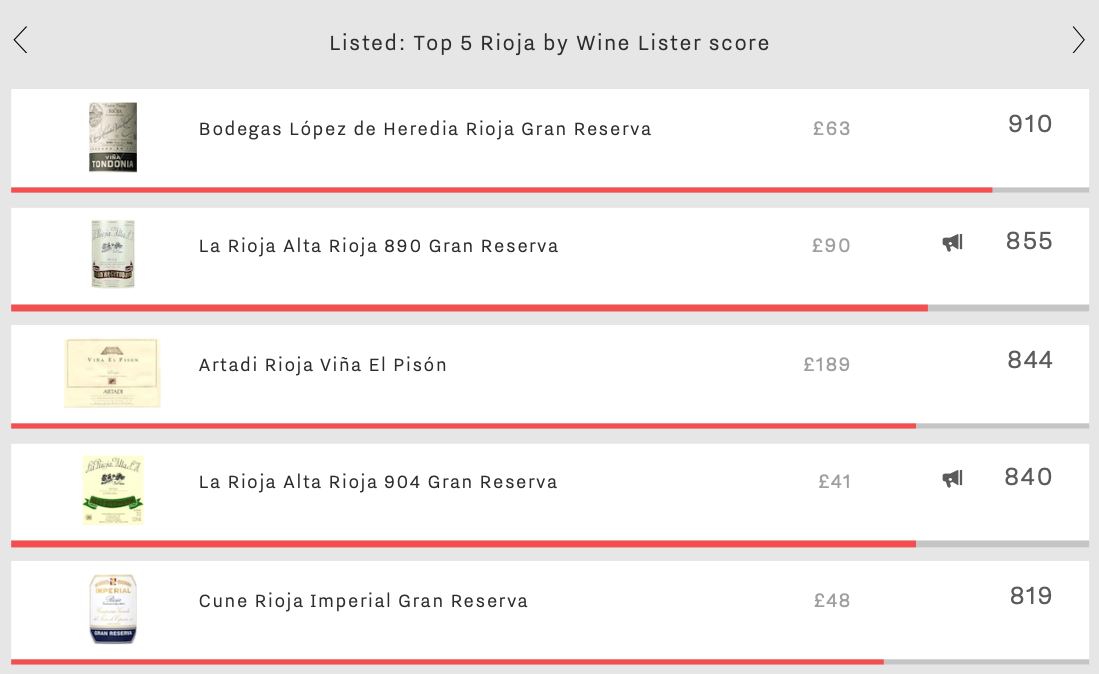
Next is the first of two wines in this week’s top five from La Rioja Alta, the 890 Gran Reserva with an overall score of 855. Its younger sibling, the 904 Gran Reserva earns fourth place in this week’s top five with a score of 840. Both wines are Buzz Brands, and while one costs more than twice as much as the other on average (£90 for 890 vs. £41 for 904), both sport similar brand successes, earning the top two spots for search rank in this week’s top five. La Rioja Alta’s 904 Gran Reserva is the 119thmost-searched-for wine of the 4,000+ wines on Wine Lister (the 890 is 284th), and earns the best Brand score of the group (902).
In third place of this week’s top five is a wine with a very different profile, not least as the only non-Gran Reserva of the group. Artadi’s Rioja Viña El Pisón achieves the lowest Brand score of the group, but the highest Quality score at 954. This combined with its low production rate of just 6,000 bottles per annum on average likely contributes towards it also having the highest price of this week’s top five, at £189 in-bond per bottle. In a global context, this price is still remarkably low for the Quality achieved – the nearest comparable Quality score for red Bordeaux is 953, achieved by Château Margaux at an average price of £422.
Finally, at number five is Cune Rioja Imperial Gran Reserva. Though middle of the range for almost every score criterion, Cune achieves the best vertical restaurant presence of the group, with an average of 1.6 vintages and/or formats in 10% of the world’s best restaurants.
With the first major set of releases for 2019 in full swing (Burgundy 2017), the Wine Lister team are already looking ahead for what else is in store for wine collectors and trade members alike. In February we expect to see the release of Barolo 2015s – set to be a more concentrated and riper vintage than the previous due to high temperatures throughout the summer. In anticipation of these, Wine Lister is examining the top five Piedmont Buzz Brands by Brand score.
Ironically, the highest-scoring brand of this week’s top five is in fact not a Barolo at all. Gaja’s Barbaresco takes the top spot with a Brand score of 975. Wine Lister partner critic Antonio Galloni gives the 2014 vintage 96 points, and comments, “this is one of the most tightly wound, intense versions of Gaja’s Barbaresco I can remember tasting. Don’t miss it”.
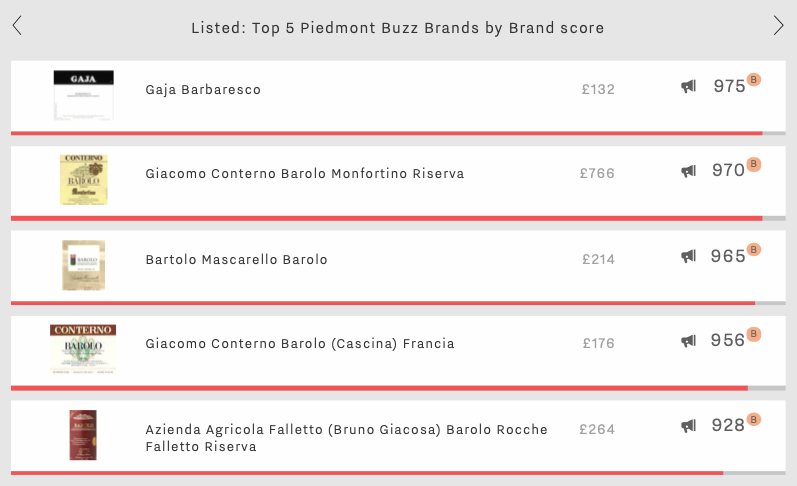
While it is no longer breaking news to see such high quality Barbaresco emerging from under Barolo’s shadow, the making of such a well-recognised brand is impressive. This is achieved by presence in 31% of the world’s best restaurants, and a search rank of 76 out of the c.4,000+ wines on Wine Lister. Gaja’s single vineyard Barbarescos, Sorì San Lorenzo, Sorì Tildin, and Costa Russi are also popular with an average Brand score of 915.
In second place for top Piedmont Buzz Brands is Giacomo Conterno’s Barolo Monfortino Riserva. Sitting just outside the top 50 most-searched-for wines (in 51stplace), it is both the highest quality and the most expensive wine of this week’s top five, with a Quality score of 977, and an in-bond per bottle price of £766. The price tag, which is just under four times higher than the average price of the other four wines of this week’s group, is perhaps due to the tiny production quantities of just c.7,000 bottles per year.
Giacomo Conterno also takes a second spot in this week’s top five – fourth place, with his Barolo Cascina Francia, which earns a Brand score of 956 and a Quality score of 960. Despite score gaps between these two wines of a mere 14 and 17 points respectively, an average of three times as many bottles are produced of Cascina Francia than its grander (and much rarer) sibling. It is available at just 23% of the price of the Barolo Monfortino Riserva – £176 per bottle in-bond.
In third place of this week’s top five is Bartolo Mascarello’s Barolo with a Brand score of 965. While its scores across the board sit in the mid-range of this week’s top five, it achieves the best long-term price performance, with a three-year compound annual growth rate (CAGR) of 34.7%.
Lastly, at number five of this week’s group is Bruno Giacosa’s Barolo Rocche Falletto Riserva with a Brand score of 928. Although the Barolo Rocche Falletto Riserva has the lowest search rank of this week’s top five (158th), online searches for this wine saw impressive increases last year (read more here). It achieves a Quality score of 974 – just two points under the best Quality performer of the group (Conterno’s Barolo Monfortino Riserva). Indeed at vintage level these two wines share a near-perfect Quality score of 998 for their respective 2004 vintages, both earning 100/100 from Antonio Galloni.
It is interesting to note the high quality that accompanies these top Piedmont Buzz Brands (an average Brand score of 959 vs. 945 for Quality). The disparity between scores is more accentuated for the equivalent group in Tuscany, which achieves a Brand score of 991 for a Quality score of 932, or in other words, a 59-point gap.
Our latest Listed blog focused on the top Grand Cru Champagnes by Wine Lister score. As the holiday season approaches, we look at a different kind of ‘top five’ on a sparkling theme – five of the major trends for the Champagne region, determined by a recent survey of Wine Lister’s Founding members.
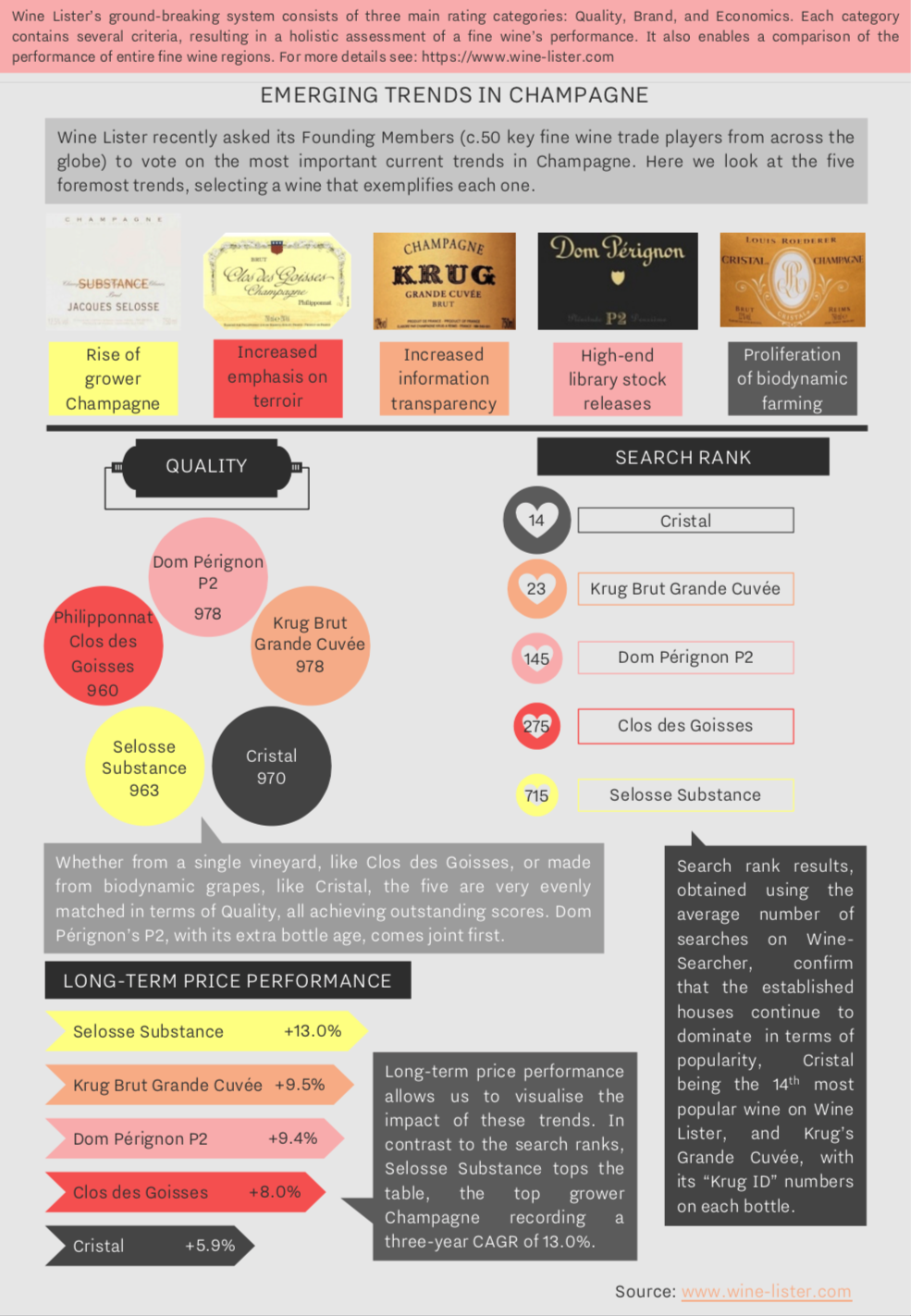
Key members of the global fine wine trade identified the rise of grower Champagnes as an emerging trend. Jacques Selosse reigns supreme, with its Blanc de Noirs La Côte Faron achieving the best Quality score of any grower Champagne on Wine Lister (975). Only an average of 1,250 bottles are produced of this each year – half of the production volume of its Substance Brut.
Founding Members also identified an increased emphasis on terroir as something to look out for. Single vineyard expressions of Champagne are well-known and already extremely sought-after, particularly Krug’s Clos du Mesnil and Clos d’Ambonnay. The latter achieves a Quality score of 970, just 10 points above Philipponnat’s Clos des Goisses, but is over 12 times the price (£1,867 vs. £147).
The phenomenon of increased information transparency is perhaps a sign that buyers are becoming more interested in Champagnes as wines, as opposed to just celebratory bubbles. Krug’s Grande Cuvée has used “Krug ID” numbers since 2011, allowing drinkers to see the vintages, vineyard plots, and grapes included in each bottle. Library releases also cater to more “wine-focused” buyers – Champagne Brand King Dom Perignon’s P2, or Bollinger R.D. are the obvious choices for this.
Finally, interest in biodynamically farmed Champagnes is on the rise, such as Louis Roederer’s Cristal, or any cuvée from Jacques Selosse.
Download a PDF of the slide above here.
First published in French in En Magnum.
Part of Wine Lister’s Brand score includes a measure of prestige, achieved by analysing a wine’s presence in the world’s best restaurants. Whether a restaurant makes the cut depend on a combination of measures including the Michelin Guide, San Pellegrino 50 Best Restaurants, and World of Fine Wine Best Wine List Awards.
The chosen wine lists are then analysed to give us the breadth (how many restaurants) and depth (how many formats and/or vintages in each restaurant) of presence achieved by each wine on Wine Lister. Looking at the former criterion, the chart below shows the top 20 biggest gainers since our last blog on the subject. (Next week we will be looking at wines with the greatest increase in depth of representation.)
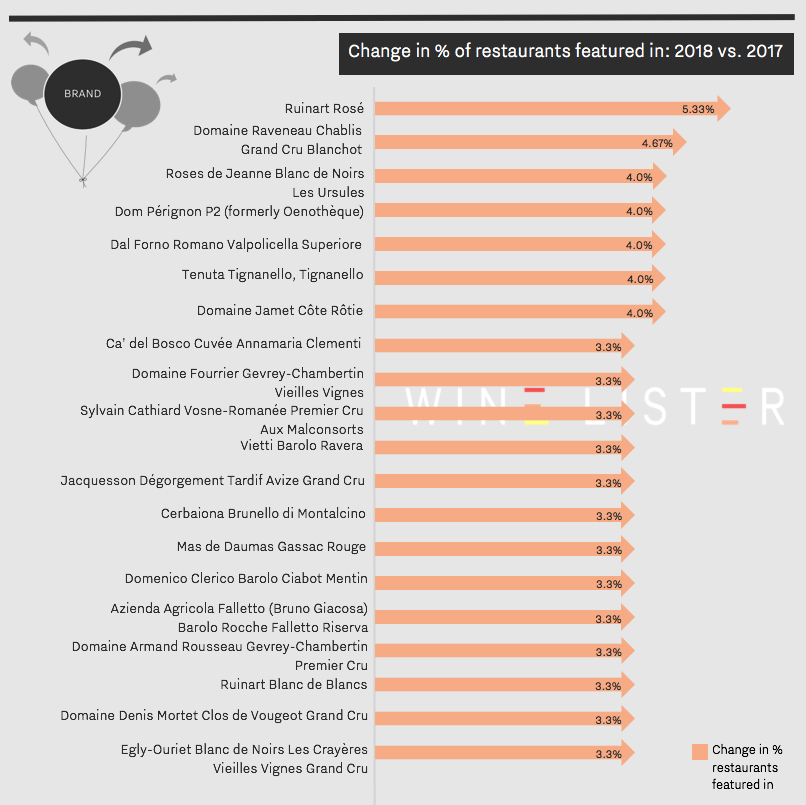
Six out of the 20 wines with the biggest increase in restaurant presence are Champagnes. Ruinart appears twice, with its NV rosé having made the greatest improvement, now appearing in 33% of the world’s best restaurants. However, the overall winner – present in more than double the number of restaurants, is Dom Pérignon’s Vintage Brut. Despite not featuring in the top 20 biggest risers above, the Champagne Brand king is now present in 69% of top restaurants worldwide, overtaking last year’s winner, Yquem.
Contrary to our last analysis on the subject, not all the biggest Champagne gainers in restaurant presence are big brands. Ruinart Rosé, Dom Pérignon P2, and Ruinart Blanc de Blancs may well fit this bill, with an average Brand score of 878, but the lesser-known three, grower Champagnes Roses de Jeanne Blanc de Noirs Les Ursules, Jacquesson Dégorgement Tardif Avize Grand Cru, and Egly-Ouriet Blanc de Noirs Les Crayères Vieilles Vignes, do not, as shown by a lower collective Brand score average of 664.
If this alone is not an indication of restaurant wine lists branching out, then perhaps the absence of Bordeaux is (indeed, a handful of Bordeaux wines with strong restaurant presence have lost a little ground since last year’s analysis). This diversification does however appear exclusive to the Old World, with no New World wines in the top 20 gainers.
Burgundy is well-represented amongst the top gainers, with one white, Raveneau’s Chablis Blanchot, and four reds: Sylvain Cathiard’s Vosne-Romanée Aux Malconsorts, Denis Mortet’s Clos de Vougeot, Armand Rousseau’s Gevrey-Chambertin, and Fourrier’s Gevrey Chambertin Vieilles Vignes.
Italy brings a show of diversity with six wines hailing from four different appellations across the 20 biggest movers. Vietti’s Barolo Ravera – one of three Barolos to feature in this list – has the lowest restaurant presence of the group (5%) and Solaia’s younger sibling, Tignanello the highest (47%).
Wine Lister periodically studies the movements of wines in and out of the four Wine Lister Indicator categories. One of these, Buzz Brands, denotes wines that achieve outstanding online popularity (measured through search rankings based on monthly searches on Wine-Searcher), and presence in the world’s best restaurants.
After analysing newcomers to the Buzz Brand segment in June, Burgundy dominates once again in our findings for October. Red Burgundy, and in particular, Gevrey-Chambertin, takes three out of the four places of this month’s new Buzz Brands.
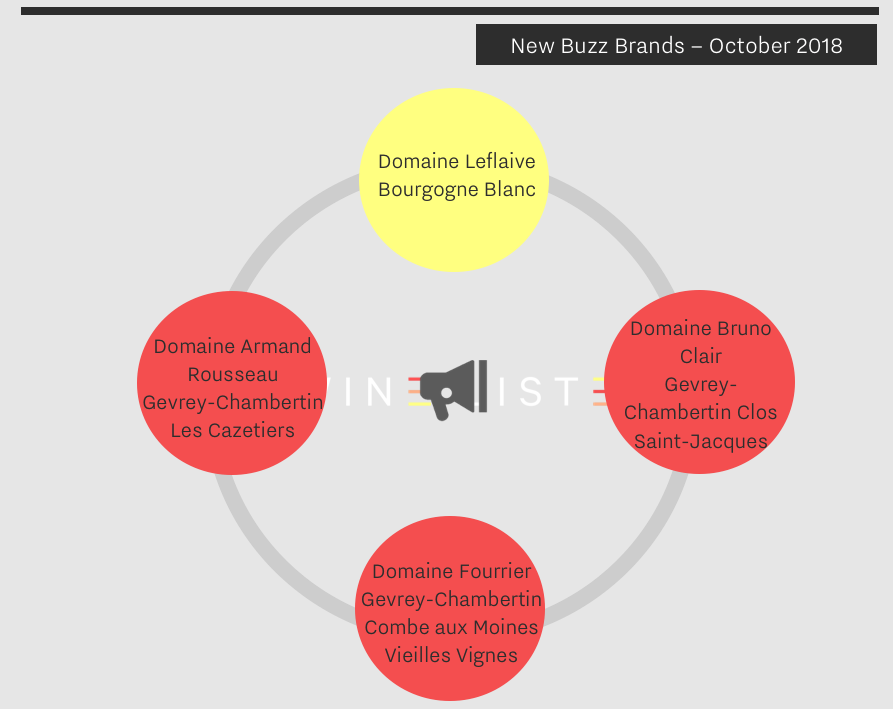
However, it is in fact the only white, Domaine Leflaive’s Bourgogne Blanc, that achieves the highest Brand score of the group at 815. All of the Domaine Leflaive wines on Wine Lister are now Buzz Brands but one – their most expensive Grand Cru, Montrachet (at £6,059 per bottle compared with £218, the average price of the rest). Indicative, maybe, of drinkers being priced out of the top wines and refocussing their interest lower down the ladder.
Perhaps it is also the sign of a good brand strategy in action, with the rising profile of the Domaine’s top wines filtering all the way down to the regional wines, via the premiers crus. The new addition of the regional offering here follows two previous new Leflaive mentions in Wine Lister’s last Buzz Brand audit (of Puligny-Montrachet Les Combettes and Meursault Sous le Dos d’Ane).
Of the three reds, two hold the same Brand score of 722, and near identical Brand profiles (see restaurant presence and search rank in the image below). The Gevrey-Chambertin Clos Saint-Jacques is the first of Bruno Clair’s wines to become a Buzz Brand. Domaine Fourrier’s Combe aux Moines Vieilles Vignes has the highest Quality score of all three new red Burgundy Buzz Brands with a score of 889. This, coupled with a slightly better Economics score helps bring it very slightly ahead for overall Wine Lister score.

Though Domaine Armand Rousseau’s Les Cazetiers is third of the Gevrey group qualitatively, it is geographically sandwiched between the first two. These wines together form a neat representation of three of the best premier cru vineyards of Gevrey-Chambertin. Incidentally, this is the last of Rousseau’s wines on Wine Lister to achieve Buzz Brand status. The domaine’s highest Brand score is won by the better-known Clos Saint-Jacques (unsurprising given that it owns roughly one third of the entire vineyard parcel) with a Brand score of 964.
This week, our Listed blog focuses on Spain’s strongest Brands. Unsurprisingly, and fittingly as we creep into autumn, all are red. It will probably also come as no shock that Bodegas Vega-Sicilia features prominently – filling an impressive three out of five spots on the list, including the top two.
Wine Lister’s Brand score combines a measure of a wine’s prestige – as indicated by its visibility in the world’s top restaurants – with its level of online popularity – calculated by ranking each of the 4000+ wines in our database by monthly search frequency on the world’s most visited wine site, Wine-Searcher. Four of this week’s top five also qualify as Buzz Brands – Wine Lister’s group of wines that perform particularly well when it comes to restaurant presence and online popularity, or are demonstrating a recent growth in popularity, and which are identified by the fine wine trade as trending or especially prestigious.
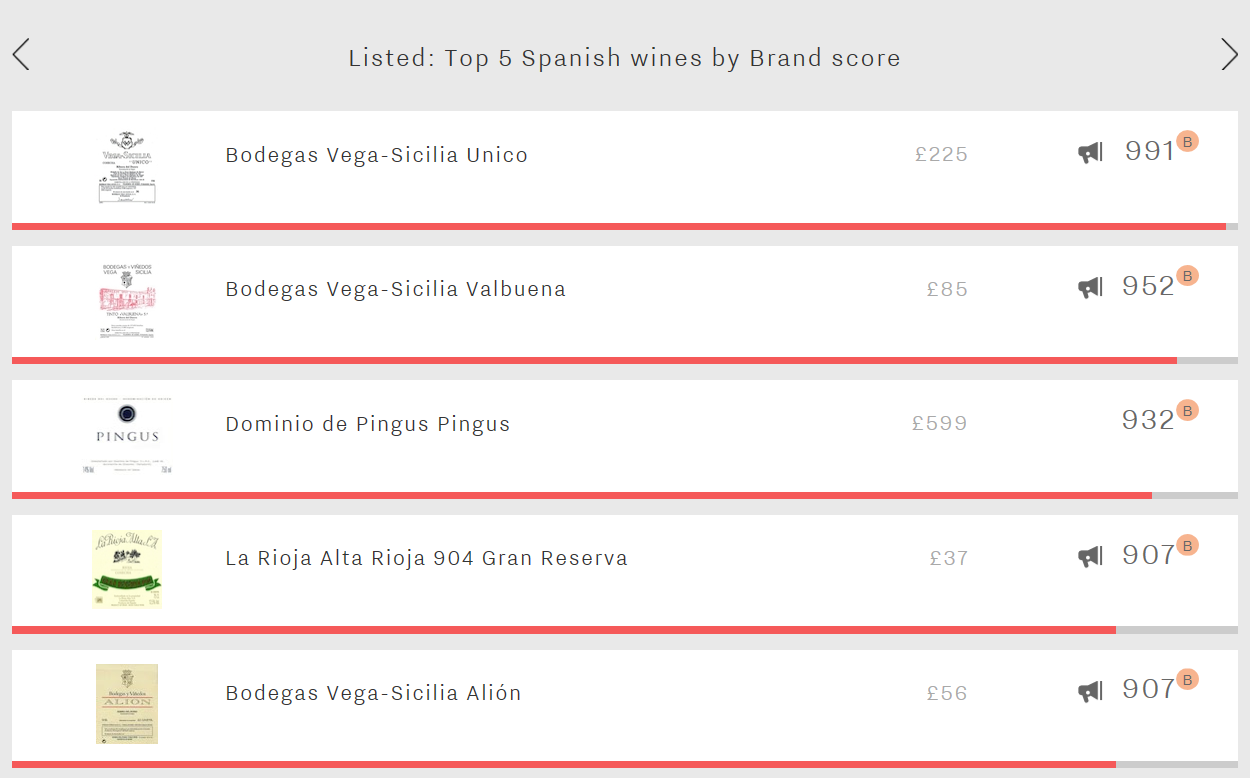
Vega-Sicilia Unico enjoys the best Brand score of any Spanish wine – and is thus the winner of this week’s race. In fact, it also achieves the highest overall Wine Lister score of all Spanish wines (974). Although Unico outperforms the rest of this week’s top five in all three of Wine Lister’s rating categories, its Brand score is particularly impressive (991). This phenomenal score is the result of excellent restaurant presence (47%) and being the 32nd most searched-for of Wine Lister’s wines on Wine Searcher.
Next, with a Brand score of 952 is Vega-Sicilia Valbuena. Despite not being able to match the Bodega’s flagship Unico in any category, it is in terms of brand recognition that it gets closest, its Quality and Economics scores trailing Unico by 115 and 54 points respectively. Its slightly lower – although still impressive – Brand score is the result of being visible in under half the number of restaurants as Unico (23%) and receiving fewer online searches (it is the 119th most popular wine on Wine Lister).
The third wine to make it onto the list is Dominio de Pingus Pingus. Presumably due to its tiny production volumes – only 6,000 bottles of it are produced each year – it is by far the most expensive of this week’s top five, at over twice the price of Unico (£599 vs £225). Its strong Brand – and high price – are supported by excellent Quality, with Pingus achieving the second highest Quality score of the group (935).
The last two places of this week’s top five are occupied by La Rioja Alta 904 Gran Reserva and Vega-Sicilia Alión. Not only do these two have identical Brand scores (907) but, despite contrasting profiles, they also share the same overall score (858). Alión achieves a higher Economics score (874 vs 729), whereas La Rioja Alta 904 records a slightly better Quality score (876 vs 812). La Rioja Alta 904 also shows that strong Brand and Quality scores do not necessarily have to mean soaring prices, as it is by far the most affordable of the five – priced at £37 per bottle on average.
It was with a heavy heart that the global fine wine trade learned of the passing of Barolo legend, Giuseppe Rinaldi, last week. Known for their elegant style and lengthy ageing potential, Rinaldi’s Barolos are not only some of the best that the region has to offer, but also some of the priciest.
In ‘Beppe’ Rinaldi’s honour, Wine Lister looks this week at the top five most expensive wines in Barolo. And there is good reason for these Barolos to be so pricey, with all of the five achieving a Quality score that falls into the “strongest” category on Wine Lister’s 1,000 point scale. On top of this, the first three qualify as Buzz Brands – Wine Lister’s group of wines that combine outstanding restaurant presence with online popularity.
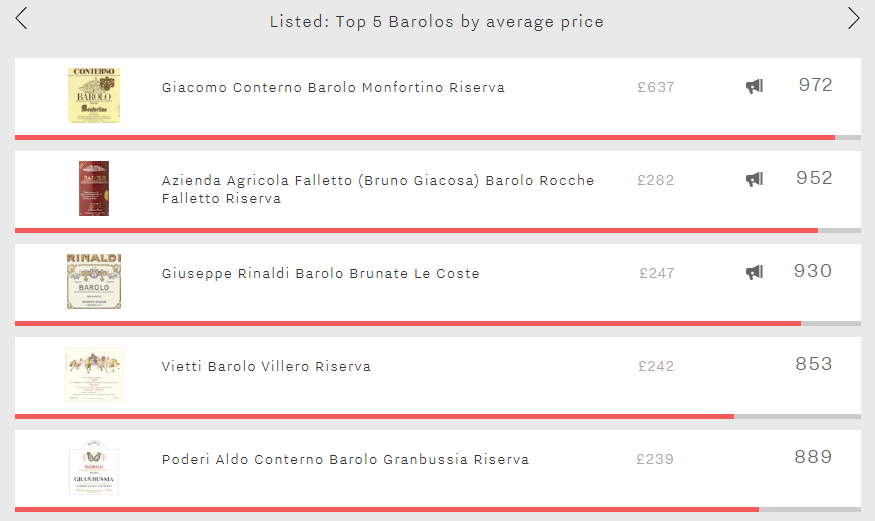
Giacomo Conterno’s Barolo Monfortino Riserva takes first place. At £637 per bottle it is more than twice the price of the rest of this week’s top five. In fact, it is the most expensive Italian wine on Wine Lister. However, it is no coincidence that Conterno’s Monfortino takes first place as it also achieves the group’s best Quality and Brand scores (977 and 969 respectively). Conterno Monfortino is actually the number one Italian wine and 11th best of all wines on Wine Lister, with an impressive overall score of 972.
This week’s second spot is occupied by Azienda Agricola Falletto (Bruno Giacosa) Barolo Rocche Falletto. Even though it competes well with Conterno Monfortino – with Quality and Brand scores of 974 and 914 respectively – it is a considerably cheaper option at £282 per bottle. In fact, despite its lower price, its Economics score is slightly superior to this week’s overall number one wine (969 vs 967), and is the group’s best. Furthermore, it is the second best of all Italian wines on Wine Lister – only beaten by Falletto’s Barbaresco Asili Riserva. The phenomenal Economics score is partly due to a three-year compound annual growth rate (CAGR) of 21.8%.
Giuseppe Rinaldi Barolo Brunate Le Coste takes third place at £247 per bottle. As perfect evidence of Rinaldi’s prowess, it is very consistent across each of Wine Lister’s three rating categories, with each score putting it amongst the very best wines in the world. Confirming its upward trajectory, it records a remarkable three-year CAGR of 36.7% – if it manages to keep that up, it will soon start to narrow the gap to Conterno’s Monfortino in this battle of the Barolos.
The two remaining wines in this group are not only very close in price but they also have the same Quality score (928). This week’s number four – at £242 per bottle – is Vietti Barolo Villero Riserva, followed closely by Poderi Aldo Conterno Barolo Granbussia Riserva at £239. Visible in 17% of the world’s top restaurants, Aldo Conterno’s Granbussia has the second-highest restaurant presence of the group. It is only beaten by this week’s number one, Conterno’s Monfortino, which is visible in 23% of top establishments.













